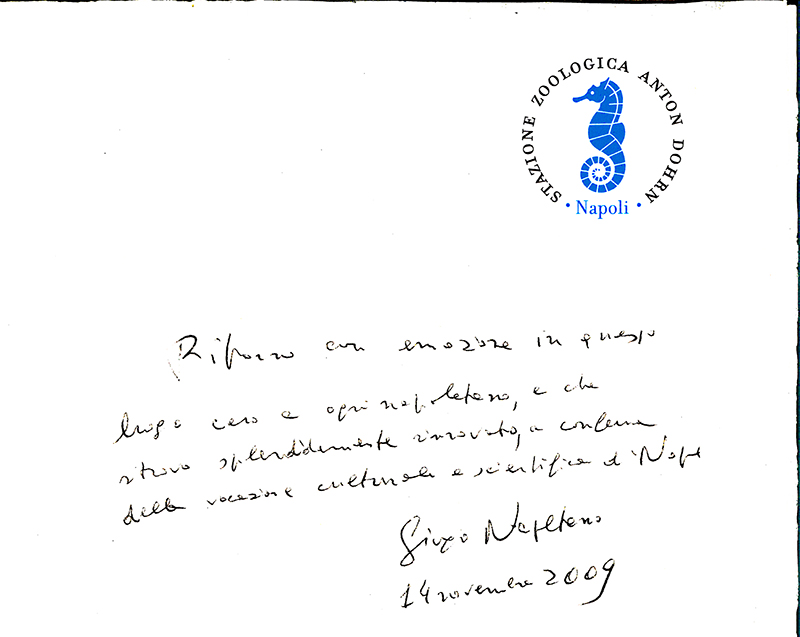Consulta le selezioni, i concorsi e tutte le opportunità a tua disposizione per lavorare alla Stazione Zoologica Anton Dohrn.
Giorgio Napolitano, 14 novembre 2009
"Ritorno con emozione in questo luogo caro a ogni napoletano, e che ritrovo splendidamente rinnovato, e conferma della vocazione culturale e scientifica di Napoli".

Secondo quanto stabilito nel proprio Statuto la SZN, per lo svolgimento delle proprie attività, nel rispetto dei vincoli di legge ed in coerenza con il proprio scopo, può:
- partecipare alla costituzione di reti di coordinamento nazionale tra Enti ed Istituzioni di Ricerca Pubblici e Privati
- partecipare ad infrastrutture finalizzate a promuovere l’eccellenza scientifica;
- partecipare o costituire Associazioni, Consorzi o Società, anche per la gestione di infrastrutture europee di ricerca, con la finalità di promuovere l’eccellenza scientifica della ricerca, la competitività in ambito internazionale e l’implementazione delle attività di terza missione;
- costituire e partecipare a fondi di investimento pubblici e/o privati previa valutazione di legittimità e di merito del MIUR ai sensi dell'art. 16 del D.Lgs. 213/09;
- promuovere la costituzione di nuove imprese (Spin off) conferendo personale proprio nel rispetto della normativa vigente.
Attualmente, la SZN partecipa a:
![]() BioSearch Srl - Spin off della Stazione Zoologica Anton Dohrn e del Consiglio Nazionale delle Ricerche
BioSearch Srl - Spin off della Stazione Zoologica Anton Dohrn e del Consiglio Nazionale delle Ricerche
partecipare alla costituzione di reti di coordinamento nazionale tra Enti ed Istituzioni di Ricerca Pubblici e Privati
La Stazione Zoologica Anton Dohrn per lo svolgimento delle proprie attività istituzionali, si avvale della collaborazione di personale di ricerca di elevata esperienza e qualificazione, sia italiano che straniero non dipendente dell’Ente e non vincolato da rapporto contrattuale subordinato.
L’associazione alla SZN viene di norma disposta per contribuire, per un periodo determinato, allo sviluppo di programmi di ricerca e previsti nell’ambito del Programma Triennale di Attività.
Per associarsi il candidato dovrà presentare la domanda ed inviarla al Presidente della SZN (presidenza(at)szn.it). L’ammissibilità del proponente verrà valutata dal Consiglio Scientifico sulla base del curriculum e della produzione scientifica.
La Stazione Zoologica Anton Dohrn nel perseguire la terza missione istituzionale conformemente a quanto previsto dall'art. 2 del proprio Statuto e dalla legislazione vigente, sostiene la valorizzazione dei risultati delle ricerche sviluppate presso le proprie strutture anche attraverso il supporto alla costituzione e al primo sviluppo di imprese Spin-off operanti in settori ad alto contenuto scientifico- tecnologico e di conoscenza negli ambiti della ricerca dell'Ente.
Con la terza missione, la SZN riconosce come proprio compito la partecipazione diretta e indiretta alla valorizzazione sociale e/o economica delle conoscenze prodotte con la ricerca svolta al suo interno. Per terza missione si intende il perseguimento di ricadute positive sulla competitività del sistema economico, sul territorio e sulla società delle attività di ricerca sviluppate all'interno dell'Ente, attraverso azioni di innovazione e trasferimento tecnologico e di conoscenza.
Con il sostegno e la partecipazione diretta alle iniziative Spin-off, la SZN intende favorire:
a) il trasferimento al sistema economico e imprenditoriale di opportunità di innovazione e progresso scientifico e tecnologico maturate nell'ambito della ricerca realizzata presso la SZN;
b) La creazione di nuovi sbocchi professionali per personale formato nella SZN e dei precari;
c) La promozione delle relazioni con il sistema produttivo;
d) La crescita del territorio locale e nazionale.
Scarica il Regolamento per la costituzione e la partecipazione alle imprese spin-off











